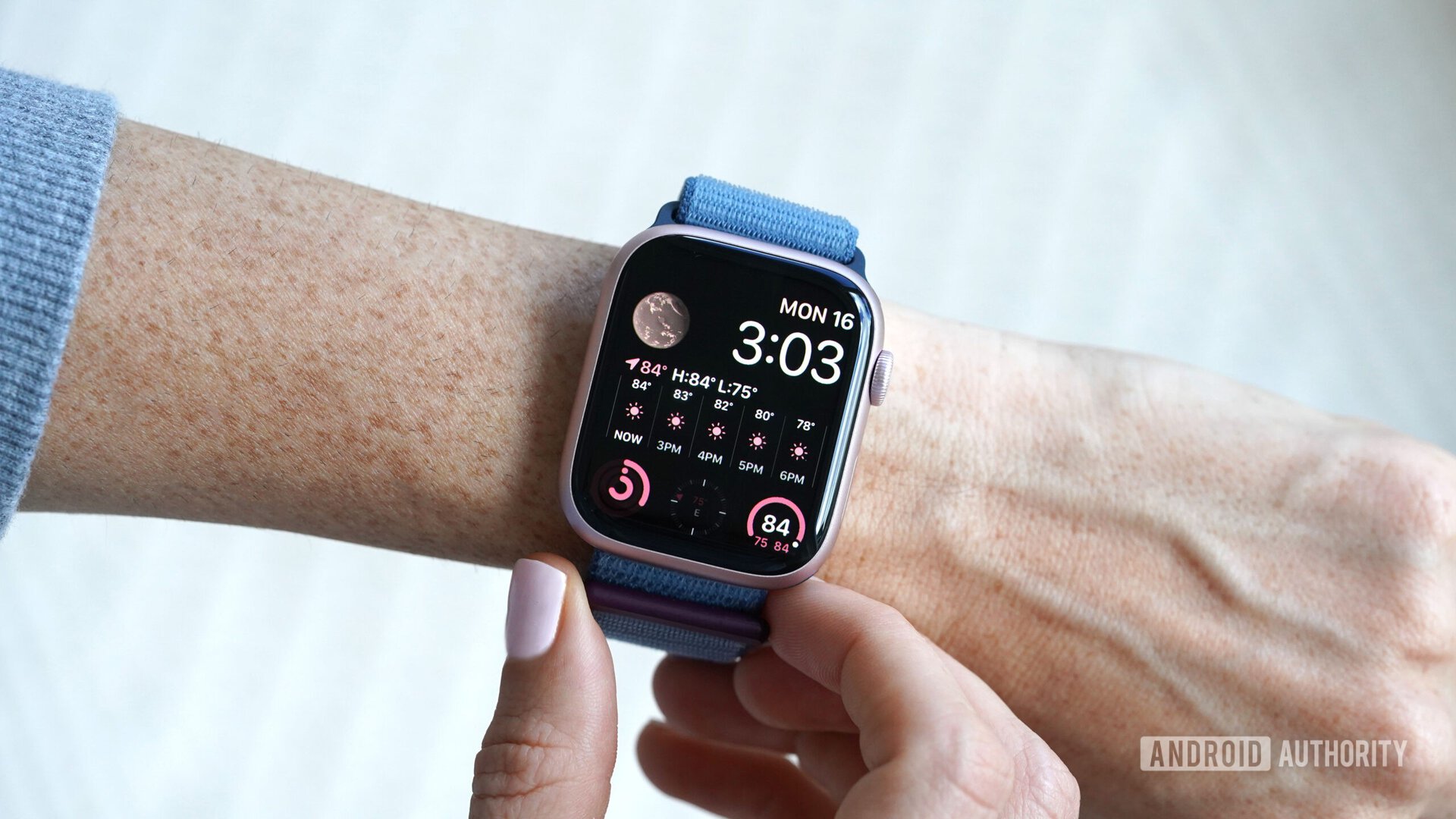Affiliate links on Android Authority may earn us a commission. Learn more.
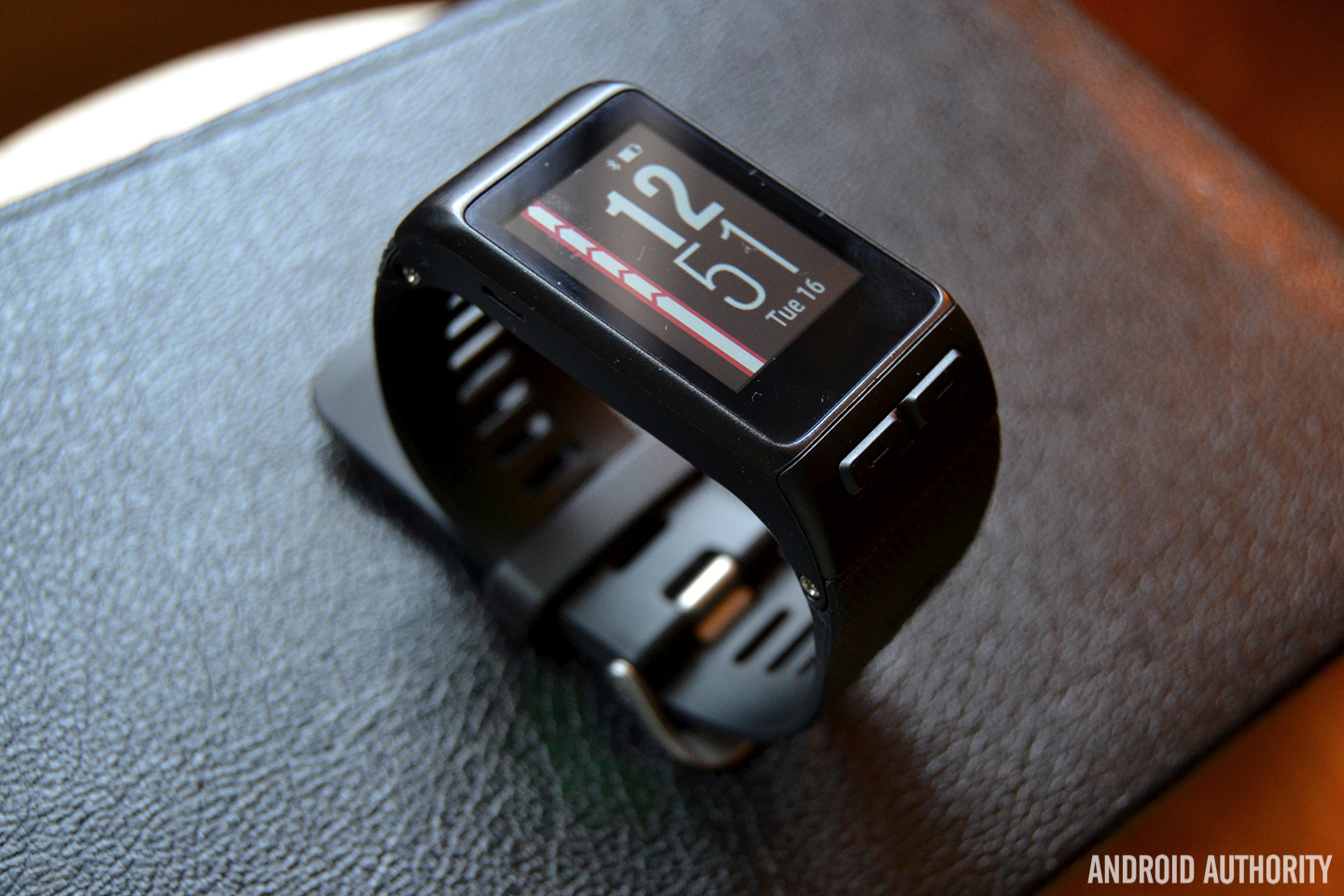
Garmin vívoactive HR review
Published onSeptember 19, 2016
Garmin vívoactive HR
What we like
What we don't like
Our scores
Garmin vívoactive HR
Garmin has been making fitness and activity trackers for quite some time now, and perhaps one of the most beefy, jack-of-all-trade offerings from the company so far is the vívoactive HR.
The vívoactive HR comes with a built-in GPS, a great water resistance rating, 8-day battery life, and an accurate heart rate monitor, but are all of those features worth the high price tag? Or should you opt for a less expensive, less feature-packed option? We answer all of those questions, and more, in our full Garmin vívoactive HR review.
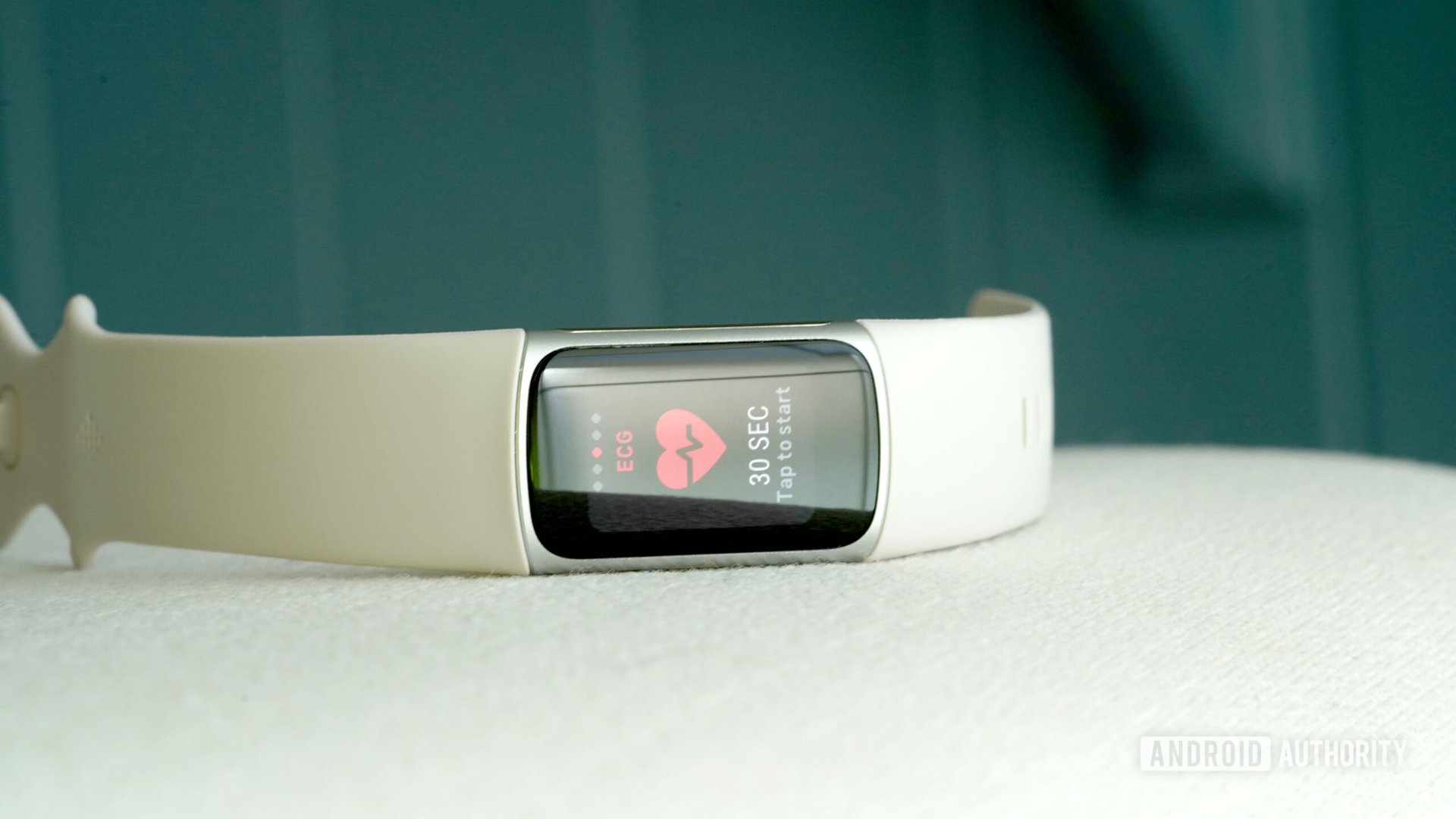
Design
The vívoactive HR is far from the most attractive fitness tracker on the market. It’s a slight step up from the design of the original vívoactive fitness watch, but it’s still not very good. It has a big, bulky design that will most likely look too big on most average-sized wrists, and will definitely look too big on smaller wrists.
This causes an obvious problem: fitness trackers should be comfortable enough to wear at all times of the day – even when you’re sleeping. When they’re not being worn, they can’t track your activity and sleep metrics, which makes them pretty much useless.
The one upside to having a bigger device on your wrist? You also get a bigger screen. The vívoactive HR sports a 1.38-inch color touchscreen display that offers more than enough room for viewing your daily stats, current workouts, the weather and more. The screen isn’t particularly easy to read outdoors, but it’s far from the worst we’ve seen on a fitness tracker. You can also adjust your backlight intensity and timeout length if you’d like in the settings menu, but honestly we haven’t found the backlight to be all that useful.
Below the display you’ll find two physical buttons. The back button sits on the left, while the menu button sits on the right side. Both buttons look nearly identical, though, so it can be a little difficult to differentiate them from one another – especially during a workout.
One other major selling point the vívoactive HR has up its sleeve: water resistance
One other major selling point the vívoactive HR has up its sleeve: water resistance. The fitness tracker has a water resistance rating of 5 ATM, meaning it can withstand pressures equivalent to a depth of 50 meters. This is a huge plus in my book.
The band on the vívoactive HR is quite nice, too. It feels high-end but not to0 rubbery, making it comfortable to wear on the skin all day. Also, if you aren’t a fan of the standard black model, you can find Lava Red, Force Yellow and White replacement bands on Amazon for about $30.
Features and performance
As we mentioned in the beginning of this review, the vívoactive HR is sort of an everything-but-the-kitchen-sink device. Not only does it offer your standard step, distance, calorie and sleep tracking, it also provides smartphone notifications, plenty of customizable watch faces, detailed weather information, current and past heart rate trends, GPS tracking and much more, right on the watch itself. It can get a little confusing when swiping through all the menus on the watch for the first time, but you’ll get used to the UI sooner than you might think.
Before we get into the vívoactive HR’s fitness tracking features, let’s first talk about all the extras. Garmin says the vívoactive HR is a “GPS smartwatch”, and they’re not kidding. You can get pretty much any notification from your phone to appear on the device, like incoming calls, missed calls, new voicemails, texts, emails, and even other applications like Facebook, Slack, Hangouts and more. Even though you can’t reply to any of them from your wrist, we’re happy the vívoactive HR provides many more notification options than other devices like the Fitbit Blaze.
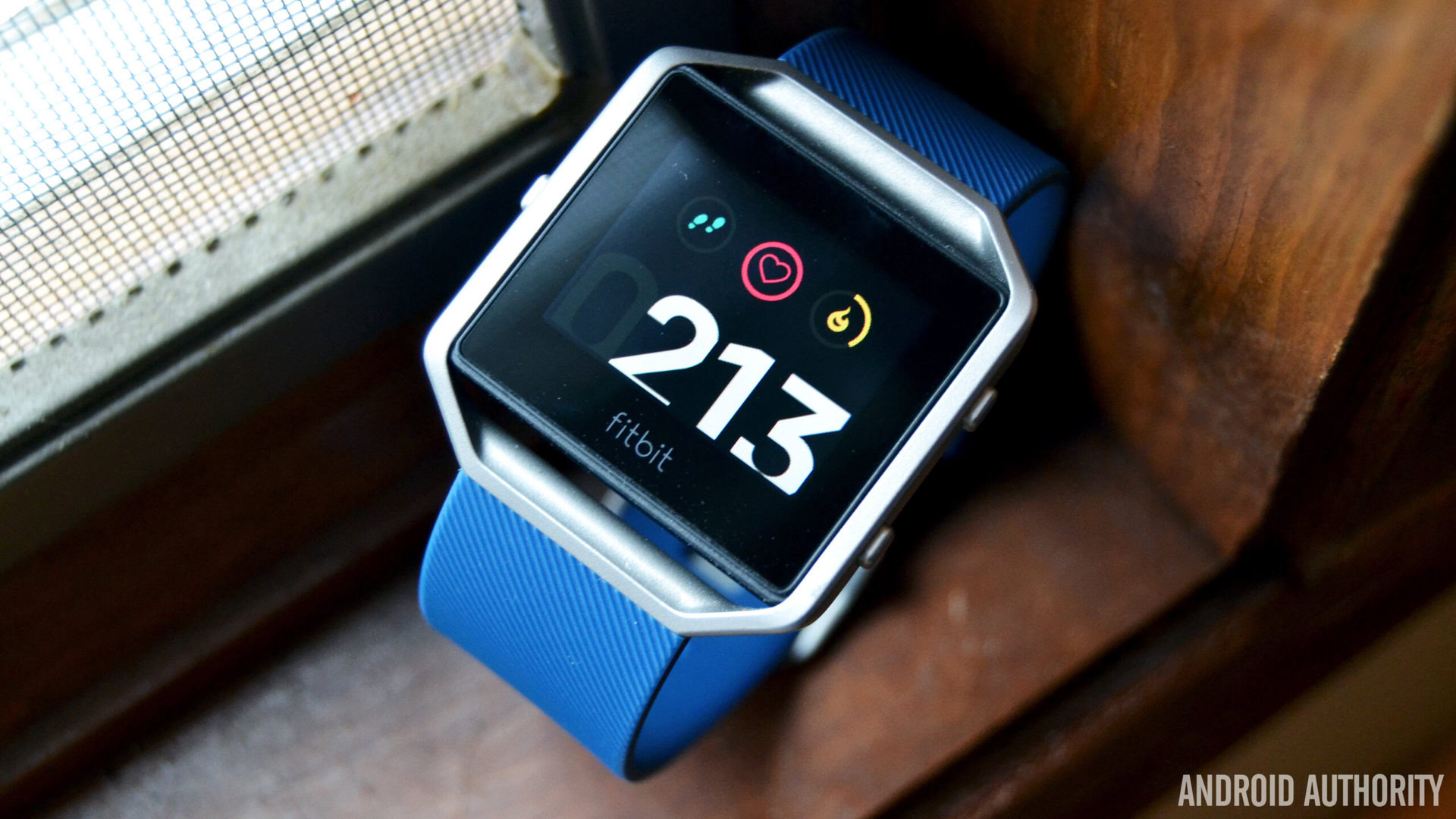
Much like most other fitness trackers on the market, the vívoactive HR will tell you to get up and move if it thinks you’ve been sitting for too long. On the left side of the main digital watch face, you’ll see a red and white bar. This is called the Move Bar. Once it fills up, the vívoactive HR will buzz and tell you to move. And once the Move Bar is cleared, you’re good to relax for another hour or so.
The vívoactive HR's sport tracking list is extensive
The vívoactive HR’s sport tracking list is extensive. Just tap the right physical button and you’ll see a list of everything the device can track. Here’s the full list of what it can track: run, bike, pool swim, golf, walk, row, SUP (stand-up paddle boarding), ski/board, XC ski, run indoor, bike indoor, walk indoor and row indoor. Not bad, right?
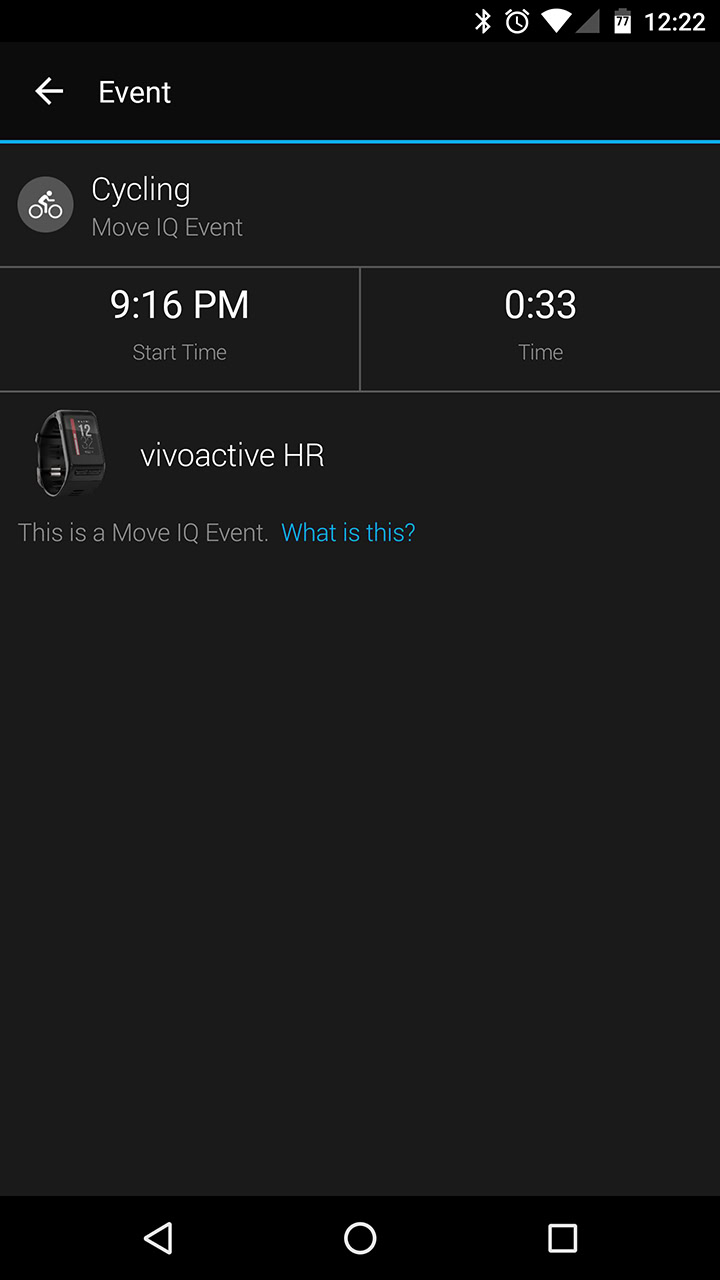
Once you tap the right button and select your workout, just wait a few seconds for the tracker to achieve a GPS connection, and you’re good to go. If you forget to select your workout, though, Garmin’s Move IQ technology will step in. Move IQ is basically Garmin’s version of automatic activity recognition, though it does come with a healthy dose of caveats. If you find yourself on a run or biking around town, the idea is that Move IQ will record that activity in the background automatically. The problem is, even if it detects you’re in the middle of a workout, it won’t enable the GPS. This means when you go into the Garmin Connect app for your workout stats, you’ll only see your workout duration, not distance. Also, these automatically recorded workouts don’t show up in the standard activity view of the app (like all other workouts), just in the calendar view.
You’ll get much more precise data if you just select your workouts manually. It can be difficult to remember sometimes, I know, but tapping a few more buttons before you begin will really be beneficial in the long run.
In terms of step tracking, the vívoactive HR is pretty much on par with most other higher-end fitness trackers on the market. As per usual, we went out and walked 500 steps with the vívoactive HR, while also comparing it with the Fitbit Surge and Garmin vívosmart HR. The vívoactive HR was actually the closest out of them all, ending with 504 steps. For reference, the Surge came in second with 506 steps and the vívosmart HR recorded 508.
You don’t buy the vívoactive HR just for its pedometer feature, though. You buy it because you need something more than what the average fitness tracker can provide. I’ve used the vívoactive HR primarily for running over this two-week review period, and we must say, it’s an incredible workout companion.
The 1.38-inch screen can show you plenty of info during a workout
When you’re in the middle of a run, the device’s big screen will be able to show you more than what other fitness trackers can at a glance. You’ll see your distance, time and pace all on the main screen. You can also swipe through (up or down) to reveal more metrics: lap distance, lap time, lap pace, heart rate, heart rate zone and average heart rate. For most runners out there, this should be more than enough info at a glance to get you through your run, though Garmin does have a pretty solid lineup of more high-end running watches if you need something more robust.
Once you’re done running, you’ll need to tap the right physical button to stop your workout, then you can choose to either save or discard what the watch just recorded. Once you save, you can then review your workout right on the watch. This short summary includes your distance, time, pace, calories burned, average heart rate, maximum heart rate, ascent and descent. I’ve found this ‘quick review’ feature very helpful after getting done with a run. It’s not always convenient to open the app to review your most recent activity right away, so this feature can really help save some time.
As far as heart rate monitoring is concerned, the vívoactive HR has one of the more accurate wrist-mounted optical heart rate sensors I’ve used thus far. To test heart rate accuracy, I’ve been comparing the vívoactive HR’s Elevate sensor with the Wahoo TICKR X heart rate monitor. Most of the time, in terms of resting heart rate, the vívoactive HR’s readings are spot on with the TICKR X, though we have noticed the Garmin device will sometimes be off by 5-8bpm or so.
Bottom line, if you want super-accurate HR readings, buy a chest-mounted heart rate monitor
The watch’s active heart rate readings are similar to those of the TICKR X as well, though I’ve found the differences to be a little more apparent. Especially during an intense run, I’ve noticed the vívoactive HR tends to lag a bit compared to the TICKR X, though the readings between the two devices are normally only 10bpm off at most. That’s par for the course when talking about wrist-based HR sensors, though. If you want the most accurate HR readings, you should opt for a chest strap. With that said, casual runners won’t be disappointed with the vívoactive HR’s readings in the slightest.
The vívoactive HR is also quite the accurate device for cyclists. After you begin your cycling trip, the vívoactive HR will display your distance, time, speed, lap distance, lap time, average speed, heart rate, heart rate zone and average heart rate. As was the case with running, these metrics should be more than enough for most cyclists out there. Once you’re done with your biking trip, you’ll be able to check more detailed metrics like average/max speed, moving time, average/max heart rate, elevation gain/loss, min/max elevation and calories burned.
Garmin's Connect app only displays a limited amount of information regarding sleep trends overtime
Sleep tracking with the vívoactive HR could be a little better. Let’s start off with the positives. Unlike with activity tracking, the watch will automatically track your sleep when it senses you’ve fallen asleep. No need to hit any buttons. When you wake up, you’ll be able to see how long you slept, how much deep and light sleep you achieved, and how often you woke up. You’ll also see graphs showing how often you move during the night.
We don’t really have any problems with the way the vívoactive HR tracks sleep; everything seems to be pretty accurate. The problem is, Garmin’s Connect app only displays a limited amount of information regarding sleep trends overtime. Checking out day-by-day sleep stats is as easy as navigating to the calendar view and selecting a particular day, but you can’t really look back at how your sleep patterns have been progressing. There’s a dedicated sleep section that’s easy enough to find in the app, though it only shows your sleep from the past seven days. It would have been much nicer to see more days included in this view, as well as suggestions for getting a better night’s sleep.
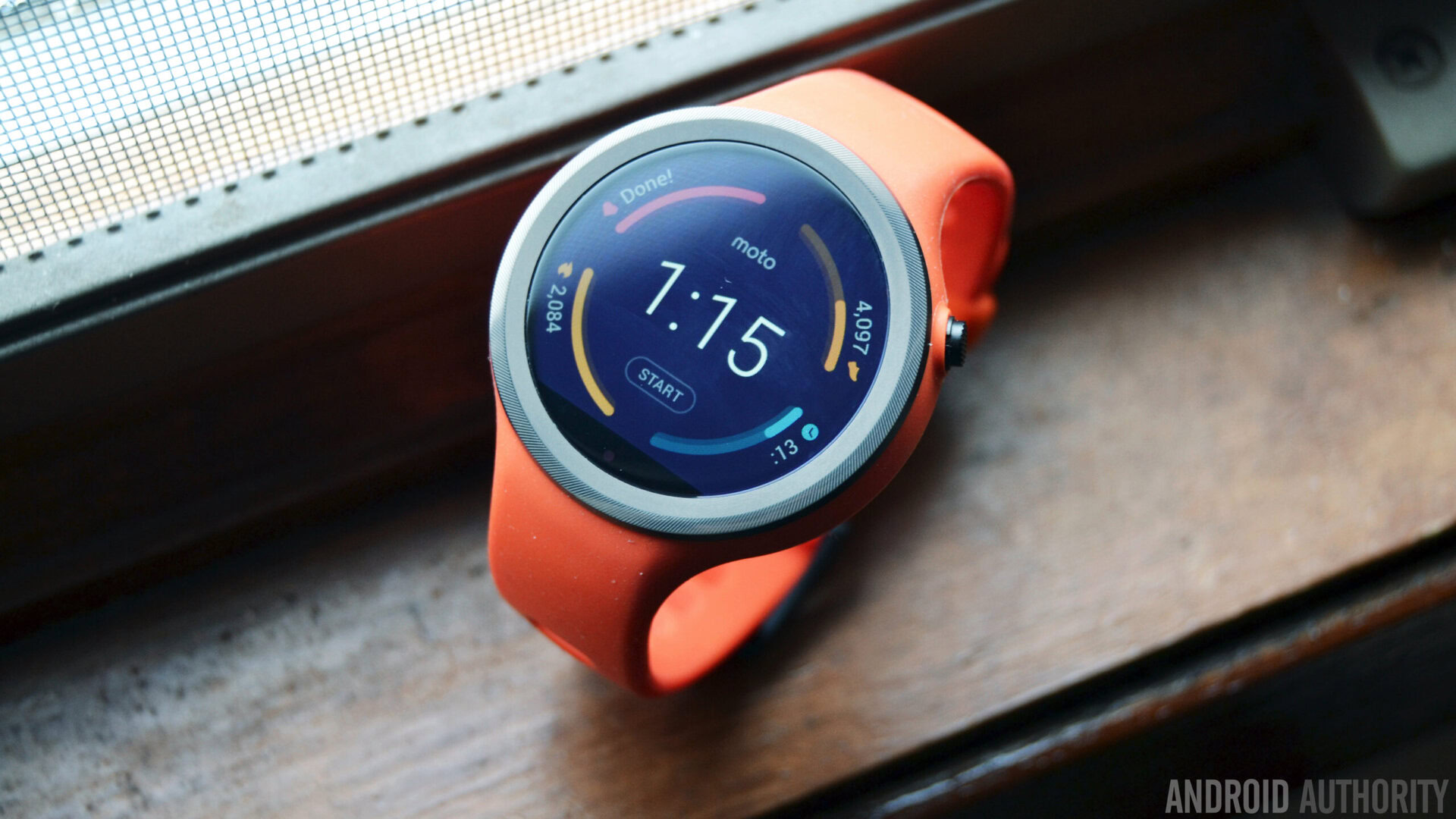
Garmin says the vívoactive HR will be able to last up to 8 days on a single charge in watch/activity tracking mode, which is in line with what I’ve been able to achieve throughout my testing period. Of course, the battery will diminish much quicker the more you use things like the heart rate sensor or GPS, so be sure to keep that in mind.
| Garmin vivoactive HR | |
|---|---|
Display | 1.38-inch touchscreen display, 183ppi |
Heart rate monitor | Yes, optical |
GPS | Yes |
Water resistance | 5 ATM (up to 50 meters) |
Sleep tracking | Yes, automatic |
Battery life | Up to 8 days |
Compatibility | Android, iOS, Windows 10 |
Colors | Black (with interchangeable bands in Lava Red, Force Yellow and White) |
Dimensions | Watch only: 30.2 x 57.0 x 11.4mm Regular: fits wrists from 137 to 195mm X-Large: fits wrists from 162 to 225mm |
Weight | Regular: 47.6g X-large: 48.2g |
Software
Like we’ve mentioned in the past, Garmin’s Connect app is sort of difficult to get used to. It’s cluttered, a tad slow and not super intuitive to navigate, though there are some really good things here if you look hard enough.
Connect is divided up into a few main sections: Snapshots, Leaderboard, Calendar, News Feed and Insights. The main Snapshot screen features all of your stats for the current day, including steps, sleep, active calories, activities, intensity minutes and floors climbed. Swiping left or right from here will bring you to more detailed pages on steps, sleep, activity, weight, and the Garmin Community. You can also add more Snapshots by tapping the top-right menu button.
Tapping on a particular Snapshot will give you more detailed information on that metric. For instance, the running Snapshot only shows distance, time, pace and your miles over the last 30 days, but tapping on any one of these areas will give you more detailed workout data.
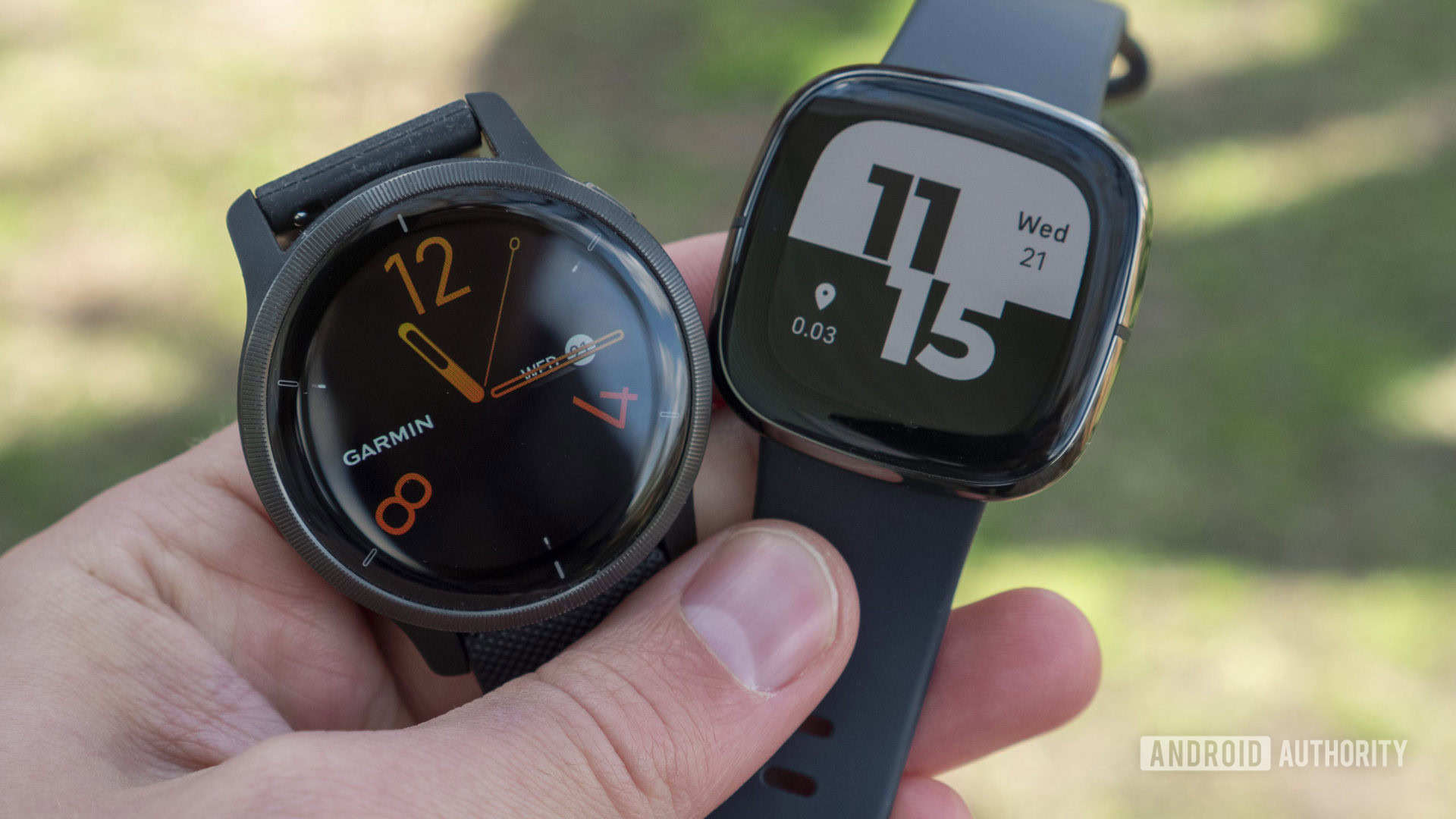
Next up is the Leaderboard section, which is where you can connect with friends who also have Garmin devices. It’s here where you can compete with your friends to achieve goals and see how everyone else is doing.
The Calendar section is mighty useful, though it can get confusing if you don’t know what you’re looking for. This is where you’ll go to find a previous workout, sleep or goal. As you can see in the screenshot below, the Calendar is presented as a month view, with different colors indicating workouts, sleep and goals. There’s no easy way to tell which color stands for what, so you might be poking around a bit to find what you’re looking for. Luckily there’s a filter option on the top-right of the Calendar to help point you in the right direction, but we’re not sure this is a good solution.
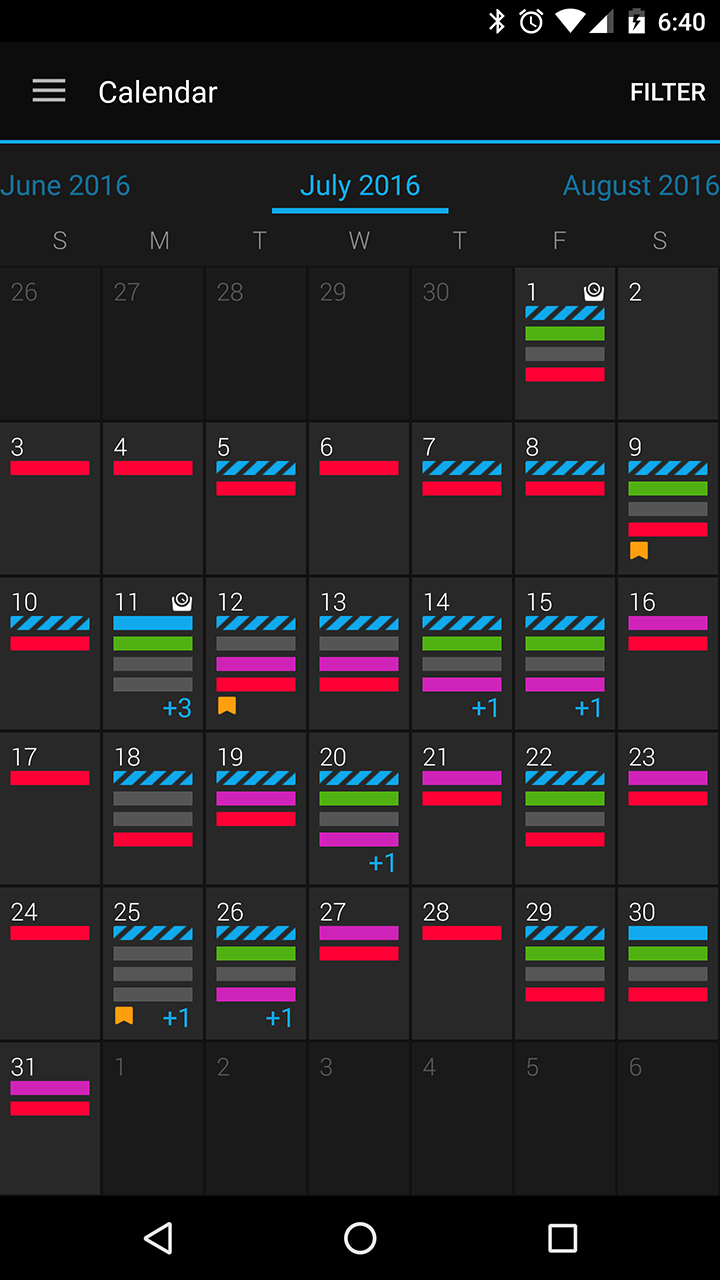
Next up is the News Feed section. This is where all of your workouts are listed from the past month. Last but not least is the Insights page, where you’ll find a list of tips and tricks from Garmin that will help you make the most of your workouts.
It’s easy to have a love/hate relationship with this app. It’s confusing, and we’re constantly finding new areas of the app we didn’t know existed. There is a lot of good information inside the Connect app, though. Garmin just needs to move around a few menus and simplify the whole experience a bit.
Gallery
Should you buy it?
If you’re looking for a fitness tracker with GPS, a big screen, water resistance and aren’t worried about size, the Garmin vívoactive HR is for you. It’s not cheap at around $250, but we can honestly say that, for the money, this is one of the better fitness trackers on the market. While Garmin does have some room to improve with its Move IQ technology and Connect app, those are very small caveats in the grand scheme of things.
How did you like our review? Is there anything you’d like to add? Be sure to let us know what you think in the comment section below!
